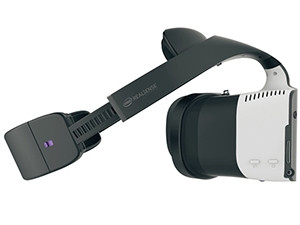
Multinational Intel claims it is the first to develop a completely wireless virtual reality (VR) headset that does not require outside components to work.
The all-in-one VR solution is called Project Alloy and was announced at the 2016 Intel Developer Forum in San Francisco this week.
The Alloy will contain a built-in 6th Gen Intel Core processor, a high-resolution screen, graphics card, lenses and battery pack.
The headset also incorporates collision detection and avoidance technology.
Other popular VR headsets on sale at the moment require a smartphone (the Samsung Gear VR), external sensors (the HTC Vive), or to be plugged into a computer (the Oculus).
Project Alloy makes use of Intel's RealSense technology, which allows the company to do away with external sensors.
RealSense is perceptual computing that understands sensory input and responds to natural movement in three dimensions.
Project Alloy allows for what Intel calls "merged reality", where users will be able to see their own body parts and surroundings while wearing the headset, and use these 'real-world' elements in the virtual world.
For example, a headset wearer will be able to use their own hands to pick up a virtual cup of coffee.
In a blog post, Intel CEO Brian Krzanich says: "Merged reality goes beyond computer-generated content. It's about bringing the real physical world into the digital world in real-time ? and reimagining it with computing power.
"Pick up your real-world tennis racket in your living room and step virtually onto the court at Wimbledon. In doing so, forgo the cost ??and creep factor? ? ?of installing high-end sensors in every corner of your living room normally needed to scan your environment," he explains.
Intel is collaborating with Microsoft to optimise Windows-based content on Intel-based VR devices such as Alloy.
Project Alloy will be offered as an open platform in 2017.
No indication of cost per unit was given.
In June, TrendForce predicted VR device shipments will reach nine million units this year.
Strategy Analytics expects global VR headset revenue to reach $895 million in 2016, with 77% of that value accounted for by newly introduced premium devices from Oculus, HTC and Sony.
Share